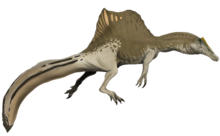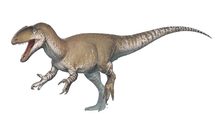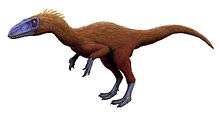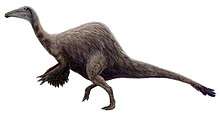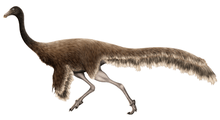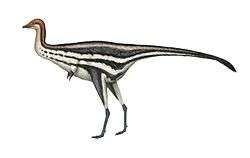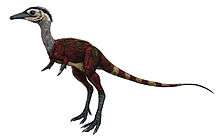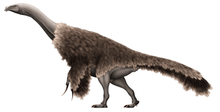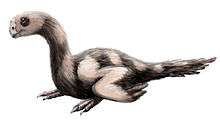Orkoraptor
Orkoraptor is a genus of medium-sized theropod dinosaur from the late Cretaceous Period of Argentina. It is known from incomplete fossil remains including parts of the skull, teeth, tail vertebrae, and a partial tibia. The specialized teeth resemble those of some maniraptoriform theropods, namely the deinonychosaurs and compsognathids. This and other anatomical features led the authors who described it (Novas, Ezcurra, and Lecuona) to suggest that it was a maniraptoran coelurosaur. However, subsequent studies found it to be a megaraptoran.[1][2] Found in the Pari Aike Formation of Southern Patagonia, it is one of the southernmost carnivorous dinosaurs known from South America.[3]
| Orkoraptor | |
|---|---|
 | |
| Artist's restoration | |
| Scientific classification | |
| Kingdom: | Animalia |
| Phylum: | Chordata |
| Clade: | Dinosauria |
| Clade: | Saurischia |
| Clade: | Theropoda |
| Clade: | †Megaraptora |
| Family: | †Megaraptoridae |
| Genus: | †Orkoraptor Novas, Ezcurra & Lecuona, 2008 |
| Species: | †O. burkei |
| Binomial name | |
| †Orkoraptor burkei Novas, Ezcurra & Lecuona, 2008 | |
Etymology
The name Orkoraptor means "Toothed River thief", and was derived from the Aoniken "Orr-Korr", the local name for the La Leona River, located near the original fossil site. The species name honors Coleman Burke, an amateur paleontologist who supported the expedition that collected the original fossils.[3]
Description
Orkoraptor was a medium-sized theropod. In 2010, Gregory S. Paul estimated its length as 6 m (20 ft) and mass as 500 kilograms.[4] In 2016 Molina-Pérez and Larramendi gave a higher estimation of 8.4 meters (27.5 ft) and 1.4 tonnes (1.5 short tons) for the holotype specimen.[5] The holotype, MPM-Pv 3457 was excavated in 2001 and consists of a right postorbital, a right quadratojugal, a probable right coronoid, eight isolated teeth, the intercentrum of the atlas and its right neurapophysis, two proximal caudal vertebrae, the proximal half of the right tibia, eight fragmentary ribs, and three incomplete chevrons. It was initially believed to be a coelurosaur due to the upturned anterior process of the postorbital as well as specialized teeth which are unserrated on the mesial (front) side and have an 8-shaped cross section, similar to those of dromaeosaurids and compsognathids. However, many other features contradict those of these families and other coelurosaurs, so its original describers were unable to conclusively assign it to any specific family. They did note its similarity to a then-undescribed Patagonian theropod now known as Murusraptor.[3] More recent analyses have explained that these coelurosaur-like traits are also present in some megaraptorans. For example, Orkoraptor's postorbital is almost identical to that of Aerosteon[1] and the juvenile Megaraptor described in 2014 has teeth similar to those of Orkoraptor.[2]
Classification
Orkoraptor was originally classified as Maniraptora incertae sedis. While the majority of phylogenetic trees recovered in its describers' analysis recovered it as a compsognathid, the describers considered this unlikely based on its much larger size and presence in much younger strata.[3] Orkoraptor was subsequently recovered in Megaraptora, a clade including several other enigmatic medium to large theropods, which has variously been considered to be a member of Allosauroidea and Tyrannosauroidea.[1][2][6] The phylogenetic trees in the publication of Gualicho shinyae have found megaraptorans to be either allosauroids or basal coelurosaurs.[7]
Provenance
All known specimens of Orkoraptor were collected from the Pari Aike Formation, which is now considered by different authors to be either the middle section of the Mata Amarilla Formation,[8] or merely an alternative name for the Cerro Fortaleza Formation.[9][10] It was originally identified as coming from the Maastrichtian, and thus the youngest known megaraptoran, but more recently is considered to be from the Cenomanian to Santonian.[8][6] The middle section of the Mata Amarilla Formation, whence Orkoraptor was collected, contains a tuff layer that has been dated to 96.2 ± 0.7 Ma, during the Cenomanian.[8]
References
- Benson, R.B.J.; Carrano, M.T; Brusatte, S.L. (2010). "A new clade of archaic large-bodied predatory dinosaurs (Theropoda: Allosauroidea) that survived to the latest Mesozoic". Naturwissenschaften. 97 (1): 71–78. Bibcode:2010NW.....97...71B. doi:10.1007/s00114-009-0614-x. PMID 19826771.
- Porfiri, Juan D.; Novas, Fernando E.; Calvo, Jorge O.; Agnolín, Frederico L.; Ezcurra, Martín D.; Cerda, Ignacio A. (2014). "Juvenile specimen of Megaraptor (Dinosauria, Theropoda) sheds light about tyrannosauroid radiation". Cretaceous Research. 51: 35–55. doi:10.1016/j.cretres.2014.04.007. hdl:11336/12129.
- Novas, F.E.; Ezcurra, M.D.; Lecuona, A. (2008). "Orkoraptor burkei nov. gen. et sp., a large theropod from the Maastrichtian Pari Aike Formation, Southern Patagonia, Argentina". Cretaceous Research. 29 (3): 468–480. doi:10.1016/j.cretres.2008.01.001.
- Paul, G. S. (2010). The Princeton Field Guide to Dinosaurs. Princeton University Press. p. 99.
- Molina Pérez & Larramendi (2016). Récords y curiosidades de los dinosaurios Terópodos y otros dinosauromorfos. Barcelona, Spain: Larousse. p. 264.
- Novas, F. E.; Agnolín, F. L.; Ezcurra, M. D.; Porfiri, J.; Canale, J. I. (2013). "Evolution of the carnivorous dinosaurs during the Cretaceous: The evidence from Patagonia". Cretaceous Research. 45: 174–215. doi:10.1016/j.cretres.2013.04.001.
- Apesteguía, Sebastián; Smith, Nathan D.; Juárez Valieri, Rubén; Makovicky, Peter J. (2016). "An Unusual New Theropod with a Didactyl Manus from the Upper Cretaceous of Patagonia, Argentina". PLOS ONE. 11 (7): e0157793. Bibcode:2016PLoSO..1157793A. doi:10.1371/journal.pone.0157793. PMC 4943716. PMID 27410683.
- Varela, A. N.; Poiré, D. G.; Martin, T.; Gerdes, A.; Goin, F. J.; Gelfo, J. N.; Hoffmann, S. (2012). "U-Pb zircon constraints on the age of the Cretaceous Mata Amarilla Formation, Southern Patagonia, Argentina: Its relationship with the evolution of the Austral Basin". Andean Geology. 39 (3): 359–379. doi:10.5027/andgeoV39n3-a01.
- Elena R. Schroeter; Victoria M. Egerton; Lucio M. Ibiricu; Kenneth J. Lacovara (2014). "Lamniform Shark Teeth from the Late Cretaceous of Southernmost South America (Santa Cruz Province, Argentina)". PLoS ONE. 9 (8): e104800. Bibcode:2014PLoSO...9j4800S. doi:10.1371/journal.pone.0104800. PMC 4139311. PMID 25141301.
- Kenneth J. Lacovara; Matthew C. Lamanna; Lucio M. Ibiricu; Jason C. Poole; Elena R. Schroeter; Paul V. Ullmann; Kristyn K. Voegele; Zachary M. Boles; Aja M. Carter; Emma K. Fowler; Victoria M. Egerton; Alison E. Moyer; Christopher L. Coughenour; Jason P. Schein; Jerald D. Harris; Rubén D. Martínez; Fernando E. Novas (2014). "A Gigantic, Exceptionally Complete Titanosaurian Sauropod Dinosaur from Southern Patagonia, Argentina (Supplementary information)". Scientific Reports. 4: 6196. Bibcode:2014NatSR...4E6196L. doi:10.1038/srep06196. PMC 5385829. PMID 25186586.



